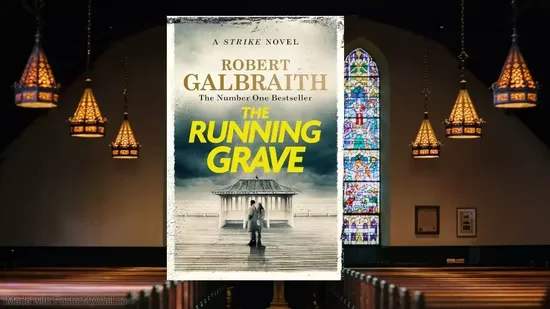J.K. Rowling, writing under the pseudonym Robert Galbraith, continues her Cormoran Strike series Novel with its seventh installment, The Running Grave. This novel, like its predecessors, follows the gripping adventures of private detective Cormoran Strike and his loyal partner, Robin Ellacott. The series began with The Cuckoo’s Calling over a decade ago and has since captivated a niche audience with its blend of crime-solving and intricate character dynamics. The Running Grave draws its title from a line in Dylan Thomas’ poem, “When, Like a Running Grave.” This book promises to dive deeper into the lives of its protagonists while delivering another intense mystery for them to solve.
The Plot of The Running Grave
In The Running Grave, Strike and Robin are hired to save a man named William from the clutches of a dangerous cult known as the Universal Humanitarian Church (UHC). The cult is infamous for manipulating and brainwashing its members, to the point where those who manage to escape often face severe mental health issues, with some even committing suicide. The task set for Strike and Robin isn’t just to extract William from the cult—it’s to dismantle the entire organization.
Robin, ever the daring and resourceful investigator, goes undercover and infiltrates the UHC. Her mission is to gather enough evidence to expose the cult’s wrongdoings and, hopefully, bring it to justice. However, the deeper she gets into the cult, the more horrifying the situation becomes. The UHC’s manipulative techniques leave members believing they must participate in unspeakable acts for the “greater good.” Robin’s time within the cult is not only dangerous but mentally taxing, as she witnesses the extreme psychological control the cult exerts on its members.

A Slow Start
One of the most significant critiques of The Running Grave is the pacing. Rowling spends a large portion of the book building up to the actual infiltration of the cult. The setup drags on for several hundred pages before the action picks up, which can be frustrating for readers eager for the mystery and suspense the series is known for. While Rowling’s meticulous attention to detail is appreciated by some, others may find the slow buildup less engaging.
However, once Robin enters the UHC, the narrative shifts gears. The tension becomes palpable as the horrors of cult life unfold. The book’s focus shifts from the methodical investigation to the emotional and psychological toll that being inside such an environment takes on Robin. Rowling does a good job of portraying the dangerous allure of cults and the difficulty of freeing oneself from their grip.
Robin and Strike: A Tense Relationship
As with previous books in the Cormoran Strike series, the dynamic between Strike and Robin is central to The Running Grave. Their relationship continues to toe the line between professional partnership and romantic tension. While there’s an undeniable bond between the two, Rowling maintains the suspense by never fully allowing their feelings for each other to be openly expressed.
In The Running Grave, we see Robin growing even more independent and resilient as she takes on the perilous task of infiltrating the cult. Her ability to think on her feet and handle stressful situations proves her to be just as capable as Strike, if not more so in certain aspects. However, the strain of the mission and the mental toll of being within the UHC create a sense of vulnerability in her character that we haven’t seen before.
The Absurdity of the “Telepathic Bond”
Despite the heavy themes of brainwashing and psychological manipulation, The Running Grave has its share of strange moments. One of the most absurd plot points comes when Robin, in the middle of a tense situation, suddenly “senses” that Strike is nearby and runs to him. This moment, where she feels a “telepathic bond” with Strike, pushes the boundaries of believability for a detective novel that typically stays rooted in the real world. While it adds a layer of emotional connection between the two characters, it feels out of place and awkward.

Rowling’s Writing: A Double-Edged Sword
One of the hallmarks of Rowling’s writing style, whether under her own name or as Robert Galbraith, is her ability to create vivid, complex characters and settings. In The Running Grave, this talent shines through in her depiction of the cult and its members. The Universal Humanitarian Church is more than just a villainous organization—it’s a fully realized entity with its own twisted logic, making it all the more terrifying.
However, this attention to detail sometimes works against the pacing of the book. The Running Grave feels overly long, with too much time spent on exposition before the actual plot takes off. At over 600 pages, the book demands patience from its readers, especially those who are more interested in the action and intrigue rather than the slow buildup.
Fan Dedication
For devoted fans of the Cormoran Strike series, The Running Grave will likely be another engrossing addition to their collection. The book offers more of the intense, slow-burn mysteries that readers have come to expect from the series, along with further development of Strike and Robin’s complex relationship.
Rowling’s ability to immerse her readers in her fictional world remains one of her strengths. Longtime fans of the series will appreciate the intricate plotlines and the emotional depth of the characters, even if the pacing is uneven at times.
The Plot: A Dangerous Cult and a Desperate Father
The main narrative of The Running Grave centers around a retired civil servant who hires Strike’s agency to rescue his son, Will, who has become ensnared in the UHC. Will no longer communicates with his family, even ignoring his mother’s death. The situation becomes even more dire as the father suspects that the UHC is not just a spiritual group but a dangerous cult. He hires Strike to extract his son and investigate the organization, which turns out to be more corrupt and criminal than anyone could have anticipated.
Robin takes on the perilous task of infiltrating the cult, pretending to be a new recruit. The mission requires her to gather enough evidence to expose the UHC’s illegal activities while also finding a way to free Will. As Robin delves deeper into the cult, she uncovers horrific truths: from sexual abuse to child trafficking, the cult’s crimes are far-reaching and terrifying. The UHC, led by a charismatic and manipulative leader, brainwashes its members into giving up their freedom, money, and autonomy in exchange for a false sense of spiritual fulfillment.
Pacing and Length: A Drawn-Out Narrative
While the plot of The Running Grave is undoubtedly gripping, one of the novel’s most significant criticisms is its length. At over 900 pages, the book takes its time to unfold, sometimes dwelling too long on Robin’s undercover work in the cult. Readers who enjoy faster-paced mysteries may find the extensive details of her time in the UHC repetitive and slow-moving. However, for those who appreciate Rowling’s character-driven approach, these scenes provide a deep dive into Robin’s psyche, as she endures both physical and emotional abuse while trying to maintain her cover.
For fans of the series, one disappointment may be the lack of interaction between Robin and Strike for much of the book. Their partnership, with its underlying romantic tension, is one of the series’ key elements, and the extended periods where they are separated can feel like a missed opportunity for more engaging dialogue and chemistry.
Robin’s Personal Growth: A Test of Endurance
Robin Ellacott has always been a strong, resourceful character, but The Running Grave puts her to the ultimate test. The emotional strain of going undercover in such a dangerous environment, coupled with her traumatic past as a rape survivor, makes her mission all the more harrowing. Throughout the novel, Robin’s determination to prove herself to Strike is palpable, but the high personal cost of this case adds layers to her character that haven’t been explored in previous books.
The reader is left on edge, worried for Robin as she faces not just the external dangers of the cult but also the internal battle of maintaining her sense of self amidst brainwashing and manipulation. Rowling does an excellent job of showing how deeply damaging cult indoctrination can be, with Robin’s resilience serving as a beacon of strength.

Strike’s Struggles on the Outside
While Robin is embedded in the UHC, Strike is left managing the agency’s caseload, balancing unreliable staff, and dealing with personal complications. His ex, Charlotte, continues to haunt him with her erratic behavior, and he’s pursued by a determined barrister, adding personal drama to his already heavy workload.
Strike’s character development in The Running Grave also takes a significant step forward. After years of suppressing his feelings for Robin, he finally admits to himself that he is in love with her. This admission brings a new dimension to the story, as readers anticipate how their relationship will evolve in future books.
A Familiar Storyline with New Depths
The cult storyline in The Running Grave may feel familiar to seasoned readers of thrillers and crime novels. The charismatic leader, the brainwashed followers, and the abuse within the organization all follow well-trodden paths. However, Rowling’s strength lies in her ability to add emotional depth to the narrative. The psychological toll on both Robin and the cult’s victims is explored in detail, making the story feel more grounded and impactful than a typical crime mystery.
The Ending: Progress in Strike and Robin’s Relationship
One of the most satisfying elements of The Running Grave is the progression in Strike and Robin’s relationship. While the two have danced around their feelings for each other in previous books, this installment finally sees Strike confronting his emotions. This subtle yet significant development hints at the possibility of a deeper connection between the two in the future, something fans have been eagerly waiting for.
Conclusion: A Dark but Rewarding Chapter
The Running Grave offers a deeply immersive experience, though its slow pacing and dark subject matter may not appeal to everyone. For fans of the Cormoran Strike series, the novel delivers on its promise of complex characters and a challenging mystery, even if it doesn’t break much new ground in terms of plot.
Despite its length and the clichéd nature of the cult storyline, the emotional depth and character development make this book a worthy addition to the series. As Robin and Strike continue to evolve, fans can look forward to what the next installments have in store, especially now that their relationship seems poised to take a new direction.
FAQs
1. What is “The Running Grave” about?
In this installment, private detectives Cormoran Strike and Robin Ellacott are hired to rescue a young man from the Universal Humanitarian Church (UHC), a group with cult-like characteristics. The investigation leads them to uncover dark secrets and confront personal traumas.
2. Can “The Running Grave” be read as a standalone novel?
While the central mystery is self-contained, reading the previous books in the series provides a deeper understanding of the main characters’ backgrounds and relationships. As one reader notes, “You should really read the series in order to understand the relationship of the main characters.”
3. What is the significance of the title “The Running Grave”?
Dylan Thomas once said, “When, like a running grave, time tracks you down.” This quote serves as the inspiration for the title. The author claims that this illustrates themes of mortality and time.
4. How has “The Running Grave” been received by critics and readers?
The novel’s complex storyline and character development have earned it favorable reviews. It debuted at number one on the UK Official Top 50 book sales list, selling 50,925 copies in its first week.
5. Are there any content warnings for this book?
Yes, the novel delves into sensitive topics, including cult dynamics, psychological manipulation, and references to past abuse. Readers who may be affected by these themes should approach with caution.
For getting more information Thezvideo.




